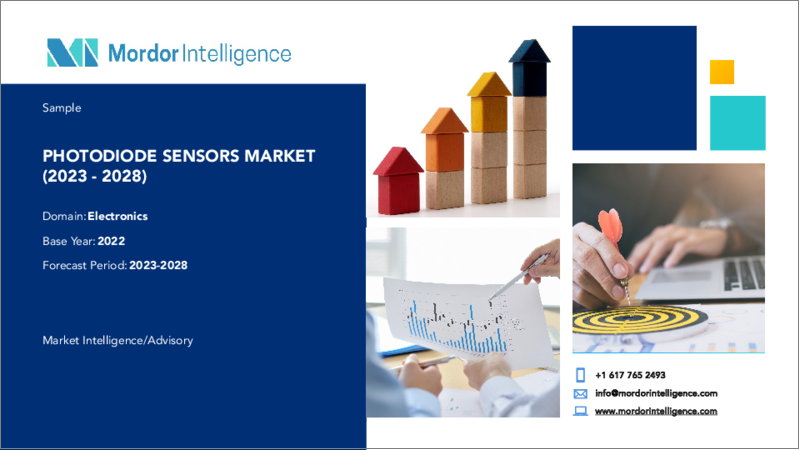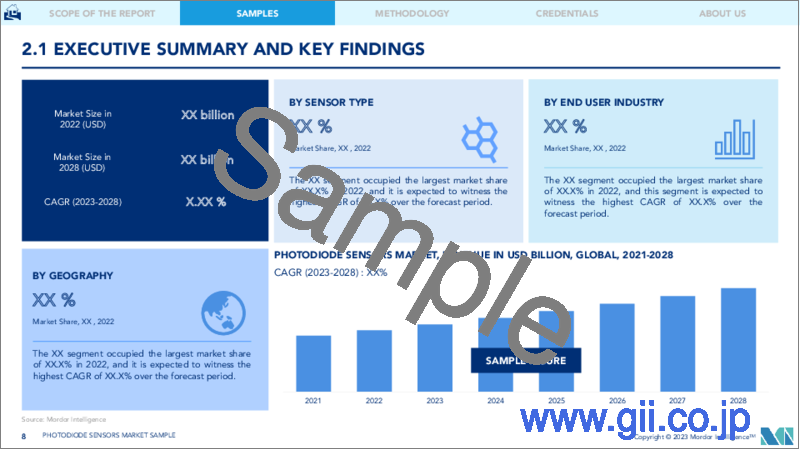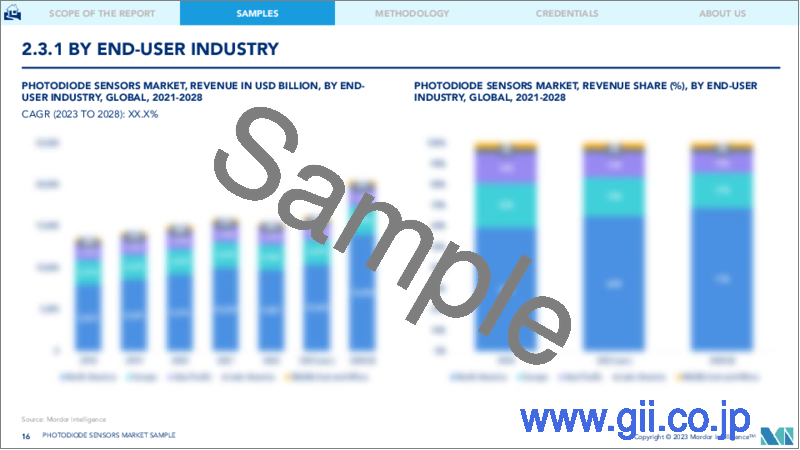|
|
市場調査レポート
商品コード
1197978
フォトダイオードセンサーの市場- 成長、動向、予測(2023年-2028年)Photodiode Sensors Market - Growth, Trends, and Forecasts (2023 - 2028) |
||||||
|
● お客様のご希望に応じて、既存データの加工や未掲載情報(例:国別セグメント)の追加などの対応が可能です。 詳細はお問い合わせください。 |
|||||||
| フォトダイオードセンサーの市場- 成長、動向、予測(2023年-2028年) |
|
出版日: 2023年01月23日
発行: Mordor Intelligence
ページ情報: 英文 100 Pages
納期: 2~3営業日
|
- 全表示
- 概要
- 目次
フォトダイオードセンサー市場は、予測期間中に7.26%のCAGRで成長すると予想されています。
パルスオキシメトリ、分光分析、医療用画像処理など、医療機器におけるフォトダイオードセンサーへの依存度が高まっているため、世界のフォトダイオードセンサー市場は大きく前進しています。また、自動車産業や家電産業における電子システムの普及が、フォトダイオードの市場拡大に拍車をかけています。
主なハイライト
- フォトダイオードセンサーは、統合された機能性、性能の向上、高い信頼性、迅速な応答時間など、際立ったいくつかの特別な特性を持っています。そのため、医療機器、航空宇宙・防衛、民生用電子機器における光/光学センサの使用拡大が、予測期間中に非常に有利なセグメントとなり、フォトダイオードセンサーの世界市場の成長に貢献すると期待されています。
- さらに、フィットネストラッカーやスマートウォッチなど、血中酸素濃度、光心拍検出、健康モニタリングなどさまざまな用途に使用されるウェアラブルヘルスデバイスも、フォトダイオードの市場を後押しすることになるでしょう。また、血圧や体温などを測定する機器にも使用されており、さらなる市場の拡大が期待されます。
- バーコード読み取りもフォトダイオードの用途の一つで、組織が多くのデータを追跡するのに役立ち、さまざまな産業で生産性や効率性を高めるために採用されています。フォトダイオードセンサー市場の拡大を牽引するもう一つの重要な要因は、小売店における顧客体験の影響力の改善と同様に、請求や購入取引の迅速な処理時間に対する認識が高まっていることです。また、こうした動きは、小売業におけるバーコードスキャナーの需要増加の原動力にもなっています。
- さらに、新しい光学検出器の開発により、フォトダイオードの需要は増加します。また、スマートフォンのカメラや近接センサーが、物体の識別や焦点合わせのためにフォトダイオードを使用するようになることも予想されます。これらの半導体技術の発展と新しいアプリケーションの出現(光通信、光センシングなど)がこの需要を後押しします。これらの要因が市場成長を後押しすることになります。
- しかし、世界のフォトダイオードセンサー市場の成長を阻む主な要因の1つは、フォトダイオードの温度依存性です。すべてのフォトダイオードには温度依存性があり、温度が変化すると暗電流、シャント抵抗、感度、耐圧に影響を与えます。また、ジャンクション容量など他の要素にも影響を与え、フォトダイオードの一般的な性能特性に悪影響を及ぼします。
- COVID-19の流行から世界経済が回復するにつれて、フォトダイオードセンサーの需要は急速に高まっています。特に、個人向け医療機器分野では、パンデミックによって人々の健康意識が高まったことで、需要の急速な高まりが見られます。したがって、センサの使用が増えることで、新たな市場開拓に拍車がかかり、ベンダーは市場での存在感をさらに高めることができます。
フォトダイオードセンサーの市場動向
アバランシェフォトダイオードセンサーが圧倒的なシェアを占める
- 光学は、医療行為に変化をもたらし、重大な健康問題に新たな解決策を提示することで人々の生活に影響を及ぼしてきました。低侵襲治療による病気の治療は、光学と光ファイバーの使用が増えることで可能になっています。光学は、レーザー手術、光学診断法、体内の可視化などを可能にしました。この医療用光学機器に搭載されるアバランシェフォトダイオードが、さまざまなメリットをもたらすことから、注目を集めています。
- アバランシェフォトダイオード(APD)は、光電効果を利用して光を電気に変換する光検出器です。光電効果を利用して光を電気に変換する光検出器で、利得を得るための機構が組み込まれています。シリコン、InGaAs、ゲルマニウムなどの材料で作られたアバランシェフォトダイオードは、数多くの産業で使用されています。医療分野での利用が、アバランシェ・フォトダイオード市場拡大の要因となっています。例えば、MedTech Europeによると、欧州における医療機器の年間成長率は、2020年に8.5%、2021年に2.9%を記録しています。
- 医療機器、特に診断機器は、最近ヘルスケア産業で需要が高まっています。血中酸素濃度を測定する医療機器には、フォトダイオードが使用されています。APD(アバランシェ・フォトダイオード)と呼ばれるシリコン上に構築された固体検出器は、光子を電荷電流に変換します。光やX線を検出する場合、小型で信頼性が高く、磁界に影響されないため、利得が100程度で、応答速度が速いという特長があります。そのため、APDはヘルスケア産業で広く活用されています。APDは、高速応答性、高性能、長寿命など、多くの特長を備えています。
- アバランシェフォトダイオード(APD)は、立ち上がりが速く、内部利得機構があり、高逆電圧で動作する高感度光検出器であるため、自動運転車、特にLiDARユニットにおいてアバランシェフォトダイオードを用いた光ネットワークが多く使用されるようになってきています。この種のフォトダイオードは、自動運転車や自動運転車の速度計測に光距離を利用するほか、交通標識認識に加え、環境モニタリング、ナビゲーション、潜在的な道路リスクなどを可能にすることから、高い需要が見込まれます。
- また、シリコン製のアバランシェフォトダイオードは、450~1000 nmの波長域で最大感度が600~800 nmと、他のタイプに比べて安価であることが特徴です。また、シリコン製のAPDは紫外から近赤外まで高い感度を持ち、微弱な光を高速で検出できるため、セグメントの成長を支えています。
アジア太平洋地域が著しい成長を遂げる
- アジア太平洋地域は、家電、自動車、通信などの産業が拡大していることから、フォトダイオードセンサー市場が最大かつ最速の成長を遂げると予想されています。中国、台湾、韓国、日本、インドなどの国々は、民生用電子機器の市場シェアを独占しています。この民生用電子機器の増加は、同地域のフォトダイオードセンサー需要の増加につながります。
- 国際貿易センターの観測によると、中国の家電製品の輸出は2020年に世界最大の市場シェアを占め、7,101億米ドルの電気機械設備、4,403億米ドルのコンピュータ、1,100億米ドルの照明および照明・その他電子製品などが含まれます。また、中国は2021年、2022年にもその地位を強化しています。したがって、中国はフォトダイオード市場の将来の成長において重要な役割を果たすと予想されます。
- さらに、鉱業、食品加工、自動車、航空宇宙、電子・半導体、繊維は、アジア太平洋地域の主要産業であり、同地域の国々の経済を支えています。これらの産業では、検査、スキャン、マッピング、プランニングにレーザデバイスや光学スキャナを使用しており、このことが同地域のフォトダイオードセンサーの需要を高め、予測期間中の市場拡大を後押しすることになります。
- また、自動車メーカーが国際規格に適合した自動車の製造に力を注いでいることから、自動車産業の成長もアジア太平洋地域の市場拡大を後押しすると予想されます。また、自動車メーカーが国際規格に適合する自動車の製造に継続的に注力しているため、このことがフォトダイオード業界のイノベーションを促進しています。
- 例えば、2021年6月、韓国のサムスン電子は、高度な120デシベル(dB)のハイダイナミックレンジ(HDR)とLEDフリッカー緩和を備えた車載用イメージセンサー、ISOCELL Auto 4ACを発表しました。90ヘルツ以上のLED光を低減する特殊な画素構造を含むCornerPixel技術を搭載しています。1つの画素領域内に2つのフォトダイオードを埋め込み、低照度画像を見るための3.0m画素と、大きな画素の隅にある1.0m画素を使用するものです。
フォトダイオードセンサー市場の競合他社分析
フォトダイオードセンサーの市場は、複数の世界プレーヤーの存在と、これらのプレーヤーの世界展開により、細分化されています。多くのプレイヤーが存在し、継続的に革新的な活動を行うことで、市場のシナリオに活力を与えています。浜松ホトニクス株式会社、Thorlabs, Inc., TT electronics, First Sensor AG, Illinois Tool Works Inc., Edmund Optics Inc., Excelitas Technologies Corporationなどがフォトダイオードセンサー市場で取り上げられている主要プレイヤーです。
- 2022年11月- ヴィッセイインターテクノロジー社は、エレクトロニカ2022で、技術のDNAと呼ばれる信頼性とエネルギー効率に優れた電子部品のポートフォリオを披露しました。同社のフォトダイオードとハイブリッドエネルギー貯蔵キャパシタを展示しました。また、Android端末にデータを送信するためのBluetooth low energyトランスミッターに電力を供給できる新しいフォトダイオードのデモを行いました。
- 2022年11月-OSI Optoelectronicsの一部門であるAdvanced Photonixは、高速応答アプリケーション向けのシリコン(Si)およびインジウムガリウム砒素(InGaAs)表面実装技術(SMT)光検出器の作成と製造を行っています。さらに、これらのフォトダイオードは、セラミック基板やプリント基板上のはんだリフロー実装や自動SMT/SMDアセンブリ用に特別に設計されています。
その他の特典
- エクセル形式の市場予測(ME)シート
- アナリストによる3ヶ月間のサポート
目次
第1章 イントロダクション
- 調査の前提条件と市場の定義
- 調査対象範囲
第2章 調査手法
第3章 エグゼクティブサマリー
第4章 マーケットインサイト
- 市場概要
- 産業の魅力-ポーターのファイブフォース分析
- 新規参入業者の脅威
- 買い手/消費者の交渉力
- 供給企業の交渉力
- 代替品の脅威
- 競争企業間の敵対関係
- COVID-19が市場に与える影響
- 技術スナップショット(シリコン、ゲルマニウム、インジウムガリウム砒素リン化物(InGaAsP)、インジウムガリウム砒素(InGaAs)
第5章 市場力学
- 市場促進要因
- 医療機器、民生機器におけるフォトダイオードセンサーの使用量増加
- 世界のスマートフォン普及率の上昇
- 市場の課題
- フォトダイオードの温度依存性
第6章 市場セグメンテーション
- センサタイプ別
- PNフォトダイオードセンサー
- PINフォトダイオードセンサー
- アバランシェフォトダイオードセンサー
- ショットキーフォトダイオードセンサー
- エンドユーザー産業別
- 民生用電子機器
- 通信分野
- 航空宇宙・防衛
- ヘルスケア
- 自動車
- 産業分野
- その他エンドユーザー
- 地域別情報
- 南北アメリカ
- 欧州
- 中国
- 日本
- 世界のその他の地域
第7章 競合情勢
- 企業プロファイル
- Hamamatsu Photonics K.K
- Thorlabs, Inc
- Edmund Scientific Corporation(Edmund Optics)
- Centronic, Ltd
- Excelitas Technologies Corporation
- Vishay Intertechnology, Inc
- ams-Osram AG
- First Sensor AG(TE Conncectivity)
- Everlight Americas, Inc
- KYOTO SEMICONDUCTOR Co., Ltd.
- Semiconductor Components Industries, LLC
- TT Electronics Plc
- OSI Optoelectronics
- Nisshinbo Micro Devices
第8章 投資分析
第9章 今後の市場展望
The photodiode sensors market is expected to grow at a CAGR of 7.26% in the forecast period. Due to the growing reliance of medical instruments on photodiode sensors for use in pulse oximetry, spectroscopic analysis, and medical imaging, the market for photodiode sensors worldwide is experiencing significant advancements. Additionally, the market expansion of photodiodes is fueled by the rising use of electronic systems in the automotive and consumer electronics industries.
Key Highlights
- Photodiode sensors have a few special characteristics that make them stand out, including integrated functionality, improved performance, high reliability, and rapid response times. Therefore, the growing use of light/optical sensors in medical devices, aerospace & defense, and consumer electronics is expected to be a highly lucrative segment during the forecast period, contributing to the growth of the global photodiode sensor market.
- Moreover, the market for photodiodes will also be boosted by Wearable Health Devices, which include fitness trackers and smartwatches and are used for various applications including blood oxygen concentration, optical heart rate detection and health monitoring. Photodiodes are also used in devices for monitoring blood pressure, body temperature, etc. which will likely fuel further market expansion.
- Barcode scanning is another use for photodiodes, which helps organizations track a lot of data and is employed to boost productivity and efficiency in a variety of industries. Another important factor driving the expansion of the photodiode sensor market is the growing awareness of the quick processing times for billing and purchase transactions as well as improvements in the impact of the customer experience in retail stores. These developments are also driving an increase in the demand for barcode scanners across the retail sector.
- Additionally, The development of new optical detectors will increase the demand for photodiodes, as will the use of photodiodes by smartphone cameras and proximity sensors to identify objects or focus on them. These developments in semiconductor technology and the emergence of new applications (optical communication, optical sensing, etc.) drive this demand. These factors will encourage market growth.
- However, one of the main obstacles to the growth of the global photodiode sensor market is the temperature dependence of photodiodes. Every photodiode has a temperature dependence that affects its dark current, shunt resistance, sensitivity, and breakdown voltage when the temperature changes. This also affects other factors, such as junction capacitance, which negatively affects a photodiode's general performance characteristics.
- The demand for photodiode sensor has been rising quickly as the global economies recover from the COVID-19 pandemic. This quick increase in demand has been witnessed especially in the personal medical devices segments as the pandemic has significantly enhanced the health conciousness of the people. Hence, the increased use of sensors spurs new developments and aids the vendors further expand their market presence.
Photodiode Sensors Market Trends
Avalanche Photodiodes Sensors Segment will Hold the Prominent Share in the Market
- Optics has impacted people's lives by altering medical practice and presenting fresh solutions to significant health issues. A less invasive approach to treating disease with minimally invasive therapies has been made possible by the growing use of optics and fiber optics. Optics has made it possible for laser surgery, optical diagnostic methods, and visualization of the body's interior. Avalanche photodiodes built into the optical machines used for medical applications have been gaining traction owing to several benefits they offer.
- Avalanche photodiodes (APDs) are photodetectors that use the photoelectric effect to transform light into electricity. They have an integral gain mechanism. Numerous industries use avalanche photodiodes, which are made of materials like silicon, InGaAs, and germanium. The use of the device in the medical field is responsible for the avalanche photodiodes market expansion. For instance, according to MedTech Europe, the annual growth rate recorded for medical devices in Europe was 8.5% in 2020 and 2.9% in 2021.
- Medical equipment, especially diagnostic equipment, has recently seen increased demand in the healthcare industry. Medical equipment that measures blood oxygen levels uses photodiodes. Solid-state detectors built on silicon called avalanche photodiodes (APDs) transform photons into charge currents. For light and x-ray detections, they offer a small, reliable, magnetic field-insensitive solution with gains in the range of 100 and quick response times. APDs are, therefore, widely utilized in the healthcare industry. APDs have many advantages, including quick response times, superior performance, and longer life.
- As, avalanche photodiodes (APDs) are highly sensitive photodetectors with fast rise time and internal gain mechanism and can be operated at high reverse voltage, optic networks built on avalanche photodiodes are increasingly being used in self-driving cars, especially in LiDAR units. This type of photodiodes are expected to be in high demand due to the use of optical distance for speed measurement in self-driving or automated driving vehices, along with their ability to enables environment monitoring, navigation, and potential road risks in addition to traffic sign recognition.
- Furthermore, avalanche photodiodes which are made of silicon are more affordable than other types and have a wavelength range of 450 to 1000 nm, with the maximum sensitivity occurring between 600 and 800 nm. Additionally, silicon-based APDs provide high sensitivity from UV to NIR for low light detection at high speeds, supporting segment growth.
Asia Pacific to Witness the Significant Growth
- The Asia Pacific region is expected to have the largest and fastest-growing photodiode sensors market because of the region's expanding consumer electronics, automotive, and telecommunications industries. Countries like China, Taiwan, South Korea, Japan, and India dominate the consumer electronics market share. This rise in consumer electronics will lead to a rise in the demand for photodiode sensors in the region.
- The International Trade Center observed that China's consumer electronics exports held the largest market share in the world in 2020, including electrical machinery and equipment worth USD 710.1 billion, computers worth USD 440.3 billion, and lighting and lighting and other electronic goods worth USD 110.0 billion. China has also bolstered its position in 2021 and 2022. Therefore it is expected that China will have a prominent role to play in the future growth of the photodiodes market.
- Additionally, Mining, food processing, automotive, aerospace, electronics & semiconductors, and textile are major industries in the Asia Pacific region that support the economies of the region's countries. These industries make use of laser devices and optical scanners for inspection, scanning, mapping, and planning which will boost the deamd for photodiode sensors in the region, supporting the studied market's expansion during the forecast period.
- Furthermore, the growth of the automotive industry is also expected to support the studied market's growth in the Asia Pacific region as automotive manufacturers are continuously focusing on manufacturing automobiles that can match the international standards. This in turn is driving innovations in the photodiode industry as vendors are continuously launching new products to cater to the growing demand.
- For Instance, in June 2021, Samsung Electronics, South Korea, introduced ISOCELL Auto 4AC, an automotive image sensor with advanced 120-decibel (dB) high dynamic range (HDR) and LED flicker mitigation. It includes CornerPixel technology, which includes a specialized pixel structure that reduces LED light above 90 hertz. It embeds two photodiodes within a single pixel area, one 3.0m pixel for viewing low light images and a 1.0m pixel at the corner of the big pixel.
Photodiode Sensors Market Competitor Analysis
The Photodiode Sensors Market is fragmented, owing to the presence of several global players and the expansion of these players globally. The presence of many players, as well as their continuous innovative activities, is energizing the market scenario. Hamamatsu Photonics K.K., Thorlabs, Inc., TT electronics, First Sensor AG, Illinois Tool Works Inc., Edmund Optics Inc., Excelitas Technologies Corporation, and others are among the major players covered in the photodiode sensors market.
- November 2022 - Vishay Intertechnology Inc. demonstrated its portfolio of reliable and energy-efficient electronic components, known as the DNA of technology, at Electronica 2022. It displayed its photodiodes and hybrid energy storage capacitors. Also, it demonstrated its new photodiodes, which can power a Bluetooth low-energy transmitter to transmit data to an Android device.
- November 2022 - Advanced Photonix, a unit of OSI Optoelectronics, creates and manufactures silicon (Si) and indium gallium arsenide (InGaAs) surface-mount technology (SMT) photodetectors for high-speed response applications. Additionally, these photodiodes are designed specifically for solder reflow mounts and automated SMT/SMD assembly on ceramic substrates and printed circuit boards.
Additional Benefits:
- The market estimate (ME) sheet in Excel format
- 3 months of analyst support
TABLE OF CONTENTS
1 INTRODUCTION
- 1.1 Study Assumptions and Market Definition
- 1.2 Scope of the Study
2 RESEARCH METHODOLOGY
3 EXECUTIVE SUMMARY
4 MARKET INSIGHTS
- 4.1 Market Overview
- 4.2 Industry Attractiveness -Porter's Five Forces Analysis
- 4.2.1 Threat of New Entrants
- 4.2.2 Bargaining Power of Buyers/Consumers
- 4.2.3 Bargaining Power of Suppliers
- 4.2.4 Threat of Substitute Products
- 4.2.5 Intensity of Competitive Rivalry
- 4.3 Impact of COVID-19 on the Market
- 4.4 Technology Snapshot (Silicon, Germanium, Indium Gallium Arsenide Phosphide (InGaAsP), Indium Gallium Arsenide (InGaAs))
5 MARKET DYNAMICS
- 5.1 Market Drivers
- 5.1.1 Increasing Usage of Photodiode Sensors in Medical Devices and Consumer Electronics
- 5.1.2 Increasing Smartphone Penetration Across the World
- 5.2 Market Challenges
- 5.2.1 Temperature Dependency of Photodiodes
6 MARKET SEGMENTATION
- 6.1 By Sensor Type
- 6.1.1 PN Photodiode Sensors
- 6.1.2 PIN Photodiode Sensors
- 6.1.3 Avalanche Photodiode Sensors
- 6.1.4 Schottky Photodiode Sensors
- 6.2 By End User Industry
- 6.2.1 Consumer Electronics
- 6.2.2 Telecommunications
- 6.2.3 Aerospace and Defense
- 6.2.4 Healthcare
- 6.2.5 Automotive
- 6.2.6 Industrial
- 6.2.7 Other End-user Industries
- 6.3 By Geography
- 6.3.1 Americas
- 6.3.2 Europe
- 6.3.3 China
- 6.3.4 Japan
- 6.3.5 Rest of the World
7 COMPETITIVE LANDSCAPE
- 7.1 Company Profiles
- 7.1.1 Hamamatsu Photonics K.K
- 7.1.2 Thorlabs, Inc
- 7.1.3 Edmund Scientific Corporation (Edmund Optics)
- 7.1.4 Centronic, Ltd
- 7.1.5 Excelitas Technologies Corporation
- 7.1.6 Vishay Intertechnology, Inc
- 7.1.7 ams-Osram AG
- 7.1.8 First Sensor AG (TE Conncectivity)
- 7.1.9 Everlight Americas, Inc
- 7.1.10 KYOTO SEMICONDUCTOR Co., Ltd.
- 7.1.11 Semiconductor Components Industries, LLC
- 7.1.12 TT Electronics Plc
- 7.1.13 OSI Optoelectronics
- 7.1.14 Nisshinbo Micro Devices




